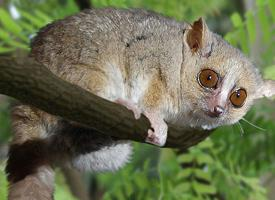
Connu aussi comme
- Maki myší
Poids et mesures
| Longueur | de 10 à 13 cm |
|---|---|
| Poids | de 70 à 100 g |
| Longueur de la queue | 15 cm |
Données biologiques
| Durée de vie | 15 r |
|---|---|
| Nombre de petits | 2-3 |
Statut de conservation
| Menacé |
Description de l'animal
The Gray Mouse Lemur (Microcebus murinus) is a captivating small primate native to the island of Madagascar. This tiny creature is part of the diverse family of lemurs, which are found exclusively on this island off the southeastern coast of Africa. Despite its name, the Gray Mouse Lemur is not a mouse, but rather a nocturnal primate that shares a distant ancestry with monkeys, apes, and humans.Characterized by its petite size, the Gray Mouse Lemur is among the smallest primates in the world. Adults typically weigh between 58 to 67 grams and have a body length ranging from 12 to 14 centimeters, with a tail that is just as long or slightly longer than its body, adding another 12 to 14 centimeters. This lemur has soft, dense fur that is predominantly gray, with lighter underparts. Its large, round eyes are a striking feature, glowing like orbs in the darkness, which enhance its night vision. This adaptation is crucial for its nocturnal lifestyle, allowing it to navigate and forage in the dark.
The Gray Mouse Lemur's diet is omnivorous, consisting of fruits, flowers, leaves, and insects. This varied diet helps it to thrive in a wide range of forest habitats, from dry deciduous forests to moist evergreen forests. Despite its small size, it is an adept climber and jumper, using its strong hind legs to leap between tree branches while foraging or escaping predators.
Socially, the Gray Mouse Lemur has interesting dynamics. It is generally solitary but can be found in loose groups during the day when it sleeps in tree holes, leaf nests, or dense foliage to avoid predators. These groups are usually comprised of family members and are temporary, forming mainly for warmth and protection. Communication among Gray Mouse Lemurs involves a variety of vocalizations, scent markings, and even facial expressions.
The breeding season for Gray Mouse Lemurs is quite short, occurring once a year. Females give birth to one or two offspring after a gestation period of about 60 days. The young lemurs are cared for exclusively by their mothers, who nurture them until they are independent enough to forage on their own.
Despite their adaptability, Gray Mouse Lemurs face significant threats from habitat destruction due to slash-and-burn agriculture, logging, and human settlement expansion. Additionally, they are sometimes captured for the pet trade or hunted for food, further endangering their populations.
Conservation efforts are in place to protect the Gray Mouse Lemur and its habitat, including the establishment of protected areas and reforestation projects. Research into their behavior, ecology, and genetics is also ongoing, providing valuable insights that can aid in their preservation.
The Gray Mouse Lemur represents the remarkable biodiversity of Madagascar and serves as a reminder of the unique wildlife that exists on this planet. Its continued survival is essential not only for the ecological balance of its habitat but also for the cultural heritage and natural legacy of Madagascar.
Carte de répartition

Nouvelles photos d'animaux
Top 10 des animaux
- Dolphin gull (Leucophaeus scoresbii)
- Japanese macaque (Macaca fuscata)
- Stone loach (Barbatula barbatula)
- Greek tortoise (Testudo graeca)
- Russian tortoise (Testudo horsfieldii)
- Galápagos tortoise (Geochelone nigra complex)
- Diana monkey (Cercopithecus diana)
- Moustached guenon (Cercopithecus cephus)
- Common flying dragon (Draco volans)
- Galápagos penguin (Spheniscus mendiculus)